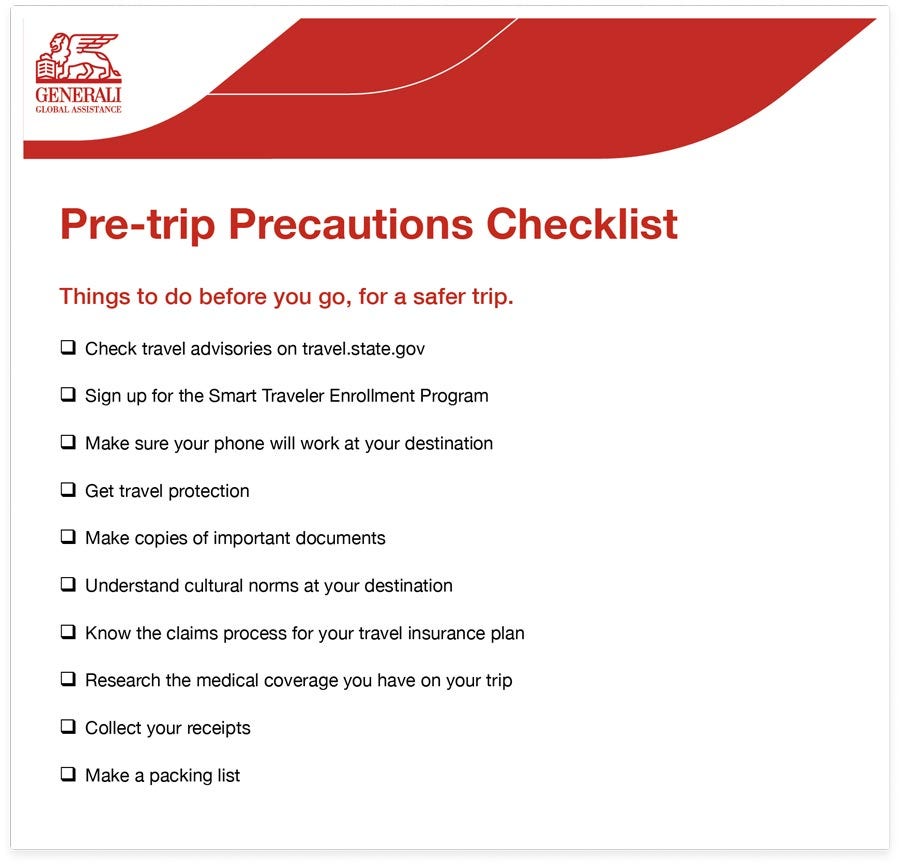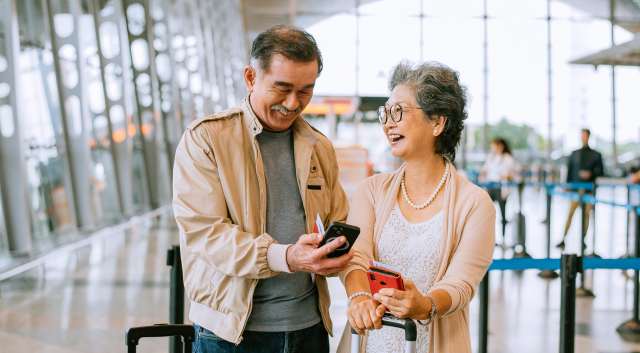Tips and Checklist: 10 Ways to Prepare for Your Next Big Trip Abroad

You’ve booked your dream trip – congratulations! But now what?
The time between booking a big trip and actually taking that trip can be nerve-wracking. It doesn’t have to be, though. Here are 10 simple things you can do to reduce your pre-trip anxiety and get you excited all at once.
An important way to tamp down pre-trip stress is to get travel insurance with Trip Cancellation coverage. It’s a relief to know that if you need to cancel your trip for a covered reason, you can get your prepaid, nonrefundable trip costs back.
Pre-Trip Precautions Checklist
You can download our Pre-Trip Precautions Checklist by clicking the button below. The accessible interactive PDF can be digitally checked off using any device or easily printed for your use.
Travel Preparation Tips
Things to do before you go, for a safer trip. See details about each step below.
Check out the latest on your destination from travel.state.gov
The State Department has a plethora of resources for travelers, from the STEP program (see below) to its travel advisories to the latest on COVID restrictions and requirements country-by-country.
A great first step for pre-travel precautions is to visit the State Department’s travel website, input your destination, and read up on everything from health requirements to cultural norms to the safe and unsafe parts of the country.
A great trip starts with being informed – and this is the best place for American travelers to get informed.
Enroll in STEP
The Smart Traveler Enrollment Program (STEP) is a collection of resources provided by the U.S. State Department and designed to help Americans travel safer and smarter wherever they go.
You sign up for STEP on a per-trip basis. Just enter your destination(s) and supply some simple information, and you’re all set up. With STEP, you’re notified of security changes and events, and other information that can help you avoid trouble on your trip.
STEP can also inform you of impending natural disasters and help with evacuation, if need be. Finally, STEP is one of the quickest ways to get you connected with the nearest embassy or consulate in case of emergency.
Want to know more about the Smart Traveler Enrollment Program?

Make sure your phone works
Not all phones work in all countries. Often all you need is a new SIM card that enables international calling (though if your phone is “locked,” that may not be something you can do easily or cheaply).
However, some non-GSM phones simply will not work in some countries. You can check for compatibility here.
You really need to do your homework on this. If you’re planning on having your phone on your trip, the last thing you want to carry around on your vacation is a brick that looks exactly like your phone.
Get travel protection
International travel can be expensive and having additional help can come in handy when you’re visiting another country. A travel protection plan with insurance coverages and travel assistance services is a must-have for any traveler these days.
Whether you want extra protection in case you need to cancel your trip for a covered reason, need coverage for medical expenses in the event of an illness or injury during your trip or one of the other dozen coverages offered, start by getting a custom quote for your trip.

Make copies of important documents and find places for them
Make sure someone back home has a copy of your passport, travel insurance plan, other insurance cards, and prescriptions – including your eyeglasses prescription. Make another copy or two to spread around your luggage.
In addition, make sure you have contact information for:
- Your travel insurance company for travel assistance and claims
- Embassies and consulates
- A medical provider back home who knows your health history
- Family and other contacts
Know the hours when you can contact these resources, too. Not everyone operates 24/7/365, or on your time zone.
Also read: How to Replace a Lost or Stolen Passport on a Trip
Check out the cultural norms at your destination
What is considered proper dress? Are there special restrictions around religious sites? What about customs for greeting and speaking. Are you traveling to a country where “cat-calling” is the norm – and what can you do about it?
Travel.state.gov is a great first stop, but you can get really in tune with your destination with cultural travel guides that give an in-depth view of the customs on where you’re going.
Understand the claims process for your travel insurance plan
You bought travel insurance for your trip, right? Well, you probably bought it hoping you never have to use it. However, when you need to utilize your travel insurance plan, do you know how to submit a claim for reimbursement?
Sometimes it’s easy to find claim-submission information on a carrier’s website. Other times, you may have to read your plan documents. Either way, it’s something important to do before you leave.

Research the medical coverage you have on your trip
Do you know what to do if you have a medical emergency on your trip? Do you have medical insurance coverage at your destination? No one likes to think about these things, but they are a huge part of traveling safely, especially for post-pandemic travel.
It’s unlikely your normal health insurance will cover you outside of the United States. Are you on Medicare or Medicaid? Then you may not have coverage in another country. These days many countries require you to have medical coverage to travel there. And you don’t want to get stuck with the medical costs – especially if you need emergency transportation. That’s why travel insurance with medical coverage is so important.
Medical emergencies are one of the top reasons for buying travel insurance. Make sure you know before you leave:
- Are pre-existing conditions covered?
- Can I choose my medical facility?
- What if I have to be evacuated?
Again, no one likes thinking about these things, but the time to think about them is when it’s not an emergency. Do it before you leave, and you’ll travel with greater peace of mind.
Read more: Why You Might Need to Buy Medical Coverage Before You Travel
Collect your receipts
When it’s six months out from your trip to Europe and you’re buying a $200 tennis racket, you’re probably not thinking, “I really need to save the receipt for this in case it gets stolen while I’m traveling.” Nobody thinks like that. But if you want maximum reimbursement for lost or stolen items, especially with travel insurance, you’ll need a receipt.
Two hints:
- Gather your expensive items before you pack and see if you can find paper receipts for them. If you can’t, hope you can track down online credit card receipts.
- Buy as many pre-trip items as you can with a travel credit card that provides replacement protection for lost/stolen items bought with the card.

Make a packing list
It’s hard to stay safe without the stuff you need, and nothing gets you in the travel frame of mind like making a packing list. There are lots of great resources to help you put together a list (like our cruise packing lists), but sometimes the best way to pack is to go list-free, put everything you think you’ll need for your trip on the bed, and start subtracting.
Two more quick notes on packing:
- Roll, don’t fold.
- Packing cubes are your best friend.
Anticipating travel can be a wonderful time – but it’s also a time to get organized and protected, so your trip is as safe as it is memorable.
Travel Resources
See AllA11492104



